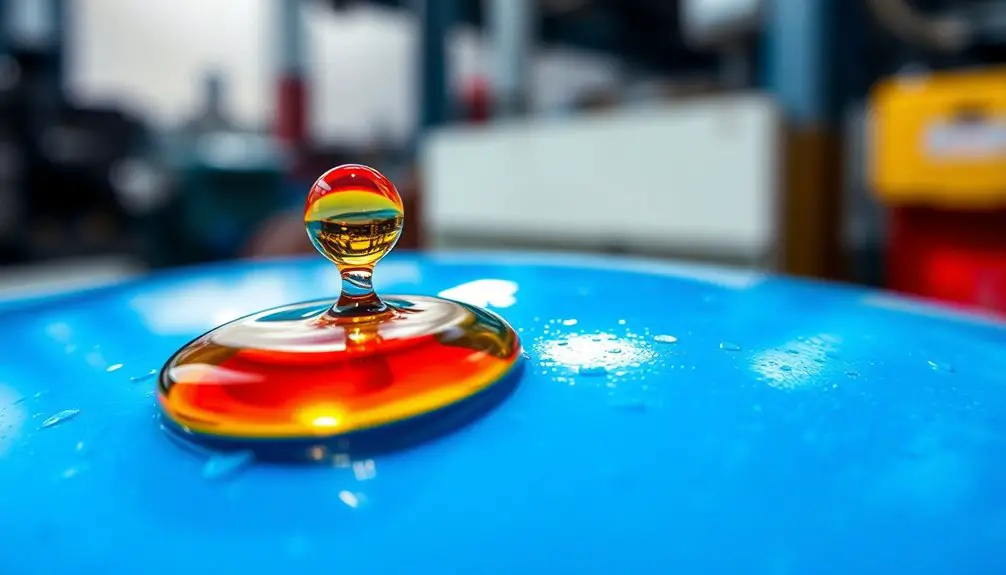Using 3-in-1 oil on plastics can indeed cause harm, especially if the plastic is PVC, polystyrene, or ABS. These materials can soften or degrade when exposed to this oil. On the other hand, plastics like nylon and Teflon usually handle 3-in-1 oil well. However, caution is still wise, even with compatible plastics. If you've got plastic components that need lubrication, consider switching to synthetic oils or specialty lubricants designed specifically for plastics. They offer safer options without risking damage. If you want to know more about the best lubricants for your needs, there's plenty to discover.
Key Takeaways
- 3-in-1 oil can damage non-compatible plastics like polystyrene, PVC, and ABS by softening and compromising structural integrity.
- Compatible plastics such as nylon, Teflon, and polypropylene generally withstand 3-in-1 oil, but caution is still advised.
- Prolonged exposure to 3-in-1 oil may lead to degradation in sensitive plastic materials, even if they are deemed compatible.
- Users have reported mixed experiences with 3-in-1 oil on plastics, with some experiencing damage and others not.
- Synthetic lubricants and alternatives like LaBelle products are recommended for safer lubrication of plastic components.
Compatibility of 3-In-1 Oil With Plastics
When considering the compatibility of 3-in-1 oil with plastics, it's crucial to understand that not all plastics react the same way to this petroleum-based lubricant.
While some plastics, like Nylon and Teflon, are compatible with 3-in-1 oil, others, particularly non-compatible plastics such as polystyrene, PVC, and ABS, can experience damage.
Many hobbyists advise against using 3-in-1 oil for plastic applications, especially with delicate plastic components, due to negative experiences reported in model trains and similar projects.
Historical accounts indicate that excessive use of this lubricating oil can lead to softening of these plastics, which can compromise their structural integrity.
Thus, it's essential to verify the compatibility of 3-in-1 oil with the specific type of plastic you're working with before applying it.
The general consensus leans toward opting for alternative lubricants like LaBelle products or synthetic oils that offer better compatibility and minimize the risk of damaging non-compatible plastics.
Always prioritize the longevity of your plastic components by selecting the right lubricant.
Exposure to certain plastics can also lead to health risks, including microplastics ingestion, which can have severe effects on human health and the environment.
Effects on Different Plastic Types
Certain plastics react differently to 3-in-1 oil, and understanding these effects can save you from potential damage.
When considering plastic compatibility, be cautious with non-compatible plastics like polystyrene, PVC, ABS, and polycarbonate. Users have reported that 3-in-1 oil can cause softening and damage to plastic components, especially in model trains and toys. If you're working with these materials, it's wise to avoid using 3-in-1 oil altogether.
On the flip side, many hobbyists have found that common plastics like nylon, Teflon, and polypropylene seem to withstand 3-in-1 oil without any notable issues.
This suggests some level of chemical compatibility with these types of plastics, but you should still proceed with caution. Additionally, the use of polypropylene is generally considered safe due to its low toxicity levels and FDA approval for food contact, which is an important factor when handling various types of plastics and chemicals.
Recommended Alternatives for Lubrication
For those looking to lubricate plastic components safely, consider switching to synthetic lubricants specifically designed for compatibility with plastics.
These lubricants, like Liquid Bearings, provide excellent protection without risking damage to your plastic models over time.
LaBelle products, particularly LaBelle 108, are highly regarded among hobbyists for their proven plastic compatibility.
They're perfect for model locomotives and other plastic applications, ensuring smooth operation without degradation.
Dapol and Peco Electrolube also offer effective alternatives, providing reliable lubrication while being safe for plastic materials.
If you're maintaining model locomotives, Gaugemaster GM619 is another solid choice.
It safeguards your models without the risks associated with traditional mineral oils, which can harm various plastic types.
Prioritizing these specialty synthetic lubricants helps you avoid potential damage, ensuring your models run smoothly for years to come.
When working with polypropylene, understanding its material properties is crucial for selecting the right lubricants and maintaining the integrity of your 3D printed models.
User Experiences and Historical Insights
User experiences with 3-in-1 oil on plastics reveal a spectrum of outcomes, reflecting a mix of satisfaction and concern. While some users report no damage after applying 3-in-1 oil to their plastic components, others have experienced degradation over time, particularly in sensitive materials like polystyrene.
Historically, since the 1950s, hobbyists have used 3-in-1 oil in model trains, yet many have noticed issues with axle and wheel performance, leading them to look for alternatives.
The primary concern arises from the oil's petroleum base, which may not be compatible with all plastics. User experiences indicate that while certain types may withstand 3-in-1 oil without immediate effects, prolonged exposure can soften and weaken these materials.
This inconsistency has prompted many to opt for synthetic lubricants, like Liquid Bearings, which are touted for their enhanced compatibility and lower degradation risks.
As you consider your lubrication options, understanding these user experiences and historical insights can guide you in making informed decisions to protect your plastic components effectively. Additionally, considering the safety concerns of plastic dog bones is crucial when evaluating the potential risks associated with using 3-in-1 oil on plastic materials, especially those designed for pet use.
Community Perspectives and Best Practices
While many hobbyists have found success with various lubricants, the community largely agrees that it's best to steer clear of 3-in-1 oil when working with plastic components. Reports indicate that even if there's no immediate damage, the long-term effects can be detrimental, especially to polystyrene and other non-compatible plastics. Hornby explicitly warns against using 3-in-1 oil for lubricating locomotives, highlighting compatibility issues. The use of proper plastic welding techniques can also help prevent damage to plastic components and ensure a strong bond between them. To help you navigate the options, here's a quick comparison of lubricants:
| Type of Lubricant | Compatibility with Plastics |
|---|---|
| 3-in-1 Oil | Not recommended |
| Synthetic Lubricants | Plastic compatible |
| Petroleum-based Oils | Risk of degradation |
Many hobbyists recommend synthetic lubricants like Liquid Bearings, as they're designed to be safe for plastics. Prioritizing model safety by using plastic-compatible lubricants can help mitigate risks associated with traditional oils. Remember, safeguarding your models today means enjoying them for years to come!
Frequently Asked Questions
Is 3 in 1 Oil Safe for Plastic?
You might wonder if 3-in-1 oil's safe for plastic. While some users report no immediate issues, many recommend avoiding it due to potential long-term damage. Consider using specialized lubricants designed specifically for plastic applications instead.
What Kind of Oil Is Safe for Plastic?
When choosing oil for plastic, opt for synthetic lubricants like Liquid Bearings or LaBelle 108. These products avoid damaging interactions, ensuring compatibility with various plastics while keeping your items functioning smoothly without risk of harm.
What Lubricant Won't Damage Plastic?
To avoid damaging plastic, you should use synthetic lubricants like Liquid Bearings or LaBelle 108. These options are specifically designed for compatibility with sensitive materials, ensuring your components stay safe and functional without degradation.
Is 3 in 1 Oil Ok for Model Trains?
Using 3-in-1 oil on model trains isn't recommended. It can soften and degrade plastic components over time. Instead, consider alternative lubricants like Liquid Bearings or Dapol Electrolube for better compatibility and protection.

